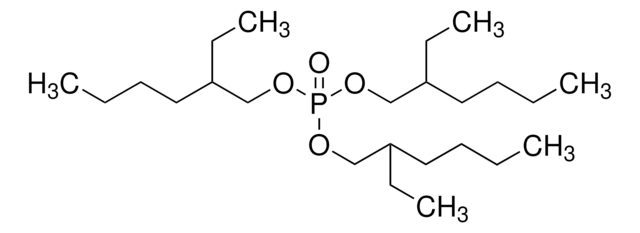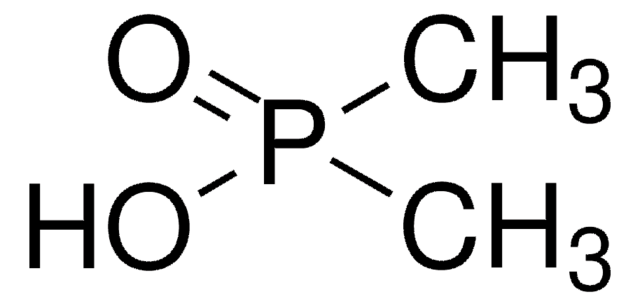68572
Dibutyl phosphate
≥97.0% (T)
Sinônimo(s):
Phosphoric acid dibutyl ester
About This Item
Produtos recomendados
Nível de qualidade
Ensaio
≥97.0% (T)
forma
liquid
densidade
1.06 g/mL at 20 °C (lit.)
grupo funcional
phosphate
cadeia de caracteres SMILES
CCCCOP(O)(=O)OCCCC
InChI
1S/C8H19O4P/c1-3-5-7-11-13(9,10)12-8-6-4-2/h3-8H2,1-2H3,(H,9,10)
chave InChI
JYFHYPJRHGVZDY-UHFFFAOYSA-N
Procurando produtos similares? Visita Guia de comparação de produtos
Descrição geral
Aplicação
- Glycosyl phosphates by using 1,2-orthoesters.
- 2-Aminophosphatesvia catalyst-free regioselective and enantiospecific SN2-type ring opening reaction with aziridines.
Características e benefícios
- Inherently biodegradable
- Stable in neutral, acidic, or alkaline solutions
Palavra indicadora
Danger
Frases de perigo
Declarações de precaução
Classificações de perigo
Carc. 2 - Eye Dam. 1 - Skin Corr. 1B
Código de classe de armazenamento
8A - Combustible corrosive hazardous materials
Classe de risco de água (WGK)
WGK 1
Ponto de fulgor (°F)
352.4 °F - closed cup
Ponto de fulgor (°C)
178 °C - closed cup
Equipamento de proteção individual
Eyeshields, Gloves, type ABEK (EN14387) respirator filter
Escolha uma das versões mais recentes:
Já possui este produto?
Encontre a documentação dos produtos que você adquiriu recentemente na biblioteca de documentos.
Os clientes também visualizaram
Nossa equipe de cientistas tem experiência em todas as áreas de pesquisa, incluindo Life Sciences, ciência de materiais, síntese química, cromatografia, química analítica e muitas outras.
Entre em contato com a assistência técnica


![1,8-Diazabiciclo[5,4,0]undec-7-eno 98%](/deepweb/assets/sigmaaldrich/product/structures/120/564/5b373e23-1624-489c-8efb-692de0f96ffb/640/5b373e23-1624-489c-8efb-692de0f96ffb.png)





![1,4-Diazabicyclo[2.2.2]octane ReagentPlus®, ≥99%](/deepweb/assets/sigmaaldrich/product/structures/366/129/a6ff4175-974d-4fac-9038-b35e508ef252/640/a6ff4175-974d-4fac-9038-b35e508ef252.png)





